
South Brisbane railway station is a heritage-listed railway station at 133 Grey Street, South Brisbane, City of Brisbane, Queensland, Australia. It is one of two stations serving the South Brisbane area, the other being South Bank. It was built from 1891 to 1918, making it the second oldest railway station in central Brisbane. It is also known as Cultural Centre Station, Melbourne Street Station, and South Brisbane (Interstate) Station. It was added to the Queensland Heritage Register on 21 October 1992.
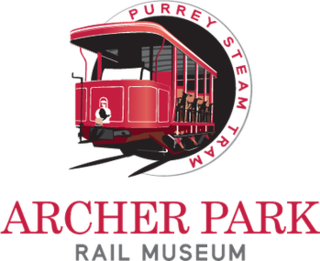
Archer Park Railway Museum is a heritage-listed former railway station and now transport museum at Denison Street, Rockhampton, Rockhampton Region, Queensland, Australia. It was built from 1897 to 1908. It was known as Archer Park railway station and Rockhampton Central railway station. It was added to the Queensland Heritage Register on 21 October 1992.
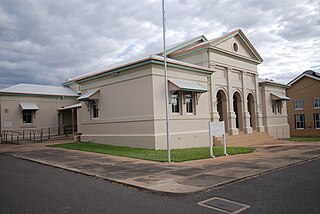
Charters Towers Courthouse is a heritage-listed courthouse at 28 Hodgkinson Street, Charters Towers City, Charters Towers, Charters Towers Region, Queensland, Australia. It was designed by John James Clark and built in 1886 by Charles Miller. It is also known as Charters Towers Courthouse. It was added to the Queensland Heritage Register on 21 October 1992.

Cardwell Bush Telegraph is a heritage-listed former post office and now heritage centre at 53 Victoria Street, Cardwell, Cassowary Coast Region, Queensland, Australia. The Telegraph and Post Office at Cardwell was designed by Colonial Architect's Office and built in 1870 by George McCallum, making it one of the oldest buildings in North Queensland.

Mitchell railway station is located on the Western line in the Maranoa Region, Queensland, Australia. It serves the town of Mitchell. The station has one platform, opening in 1885. The station has a number of heritage-listed buildings, including the passenger station in Oxford Street, the goods shed in Alice Street, and the station master's house in Sheffield Street. The buildings were added to Queensland Heritage Register on 8 September 2005.

Maryborough railway station is a heritage-listed railway station at Lennox Street, Maryborough, Fraser Coast Region, Queensland, Australia. It is on the North Coast line serving the city of Maryborough. It was designed by Chief Engineer of the Queensland Railways Department and built from 1878 to 1890 by John Roddam & John Walker. It was added to the Queensland Heritage Register on 21 October 1992.

Warwick railway station is a heritage-listed railway station on the Southern railway line in Warwick, Southern Downs Region, Queensland, Australia. It was built from c. 1881 to 1910s. It was added to the Queensland Heritage Register on 24 September 1999.

Emerald railway station is a heritage-listed railway station on the Central Western railway line at Clermont Street, Emerald, Central Highlands Region, Queensland, Australia. The building design was signed by Henrik Hansen was built in 1900 by Thomas Moir. It was added to the Queensland Heritage Register on 21 October 1992.

Longreach railway station is the terminus station of the Central Western line, serving the town of Longreach, Longreach Region, Queensland, Australia. It is on the Landsborough Highway. It was built from 1887 to 1917. It was added to the Queensland Heritage Register on 12 December 2005.

Childers Post Office is a heritage-listed former post office at Bruce Highway, Childers, Bundaberg Region, Queensland, Australia. It was designed by Queensland Colonial Architect's Office and built from 1890 to 1910. It is also known as Childers Heritage Shop. It was added to the Queensland Heritage Register on 24 January 2003.
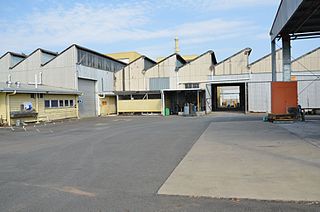
Rockhampton Railway Workshops is a heritage-listed railway workshop at 380 Bolsover Street, Depot Hill, Rockhampton Region, Queensland, Australia. It was built from 1915 to 1953. It is also known as Rockhampton Roundhouse. It was added to the Queensland Heritage Register on 21 August 1992.

Alexandra Railway Bridge is a heritage-listed railway bridge adjacent to North Street, Rockhampton, Rockhampton Region, Queensland, Australia. It was designed by Henry Charles Stanley and built from 1898 to 1899 by George Charles Willcocks. It was added to the Queensland Heritage Register on 21 October 1992.

AMP Building is a heritage-listed office building at 183 East Street, Rockhampton, Rockhampton Region, Queensland, Australia. It was designed by Francis Drummond Greville Stanley and built in 1888. It is also known as Brahman House. It was added to the Queensland Heritage Register on 21 October 1992.
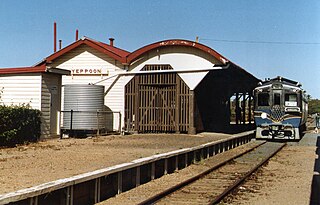
Yeppoon railway station is a heritage-listed railway station at James Street, Yeppoon, Shire of Livingstone, Queensland, Australia. It was added to the Queensland Heritage Register on 18 April 2008.

Croydon Shire Hall is a heritage-listed town hall at Samwell Street, Croydon, Shire of Croydon, Queensland, Australia. It was built c. 1892. It is also known as Croydon Shire Office and Croydon Town Hall. It was added to the Queensland Heritage Register on 11 June 1996.

Burketown Post Office is a heritage-listed former post office at Musgrave Street, Burketown, Shire of Burke, Queensland, Australia. It was designed by George Connolly and built in 1887. It is also known as Burketown Tourist Information Centre. It was added to the Queensland Heritage Register on 1 January 1993.
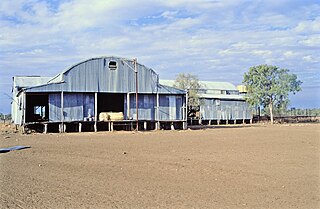
Darr River Downs is a heritage-listed homestead at Landsborough Highway, Morella, Longreach Region, Queensland, Australia. It was built from 1870s circa to 1900s circa. It was added to the Queensland Heritage Register on 27 June 2003.

Barcaldine Shire Hall is a heritage-listed town hall at Ash Street, Barcaldine, Queensland, Australia. It was designed by Alfred Mowbray Hutton and built from 1911 to 1912 by Robinson & Freeman. It was added to the Queensland Heritage Register on 29 April 2003.

Tambo Post Office is a heritage-listed former post office and now museum at Arthur Street, Tambo, Blackall-Tambo Region, Queensland, Australia. It was built in 1876 and 1885. It is also known as Post and Telegraph Office Tambo and Tambo Telecommunications Museum. It was added to the Queensland Heritage Register on 21 October 1992.

The 1873 Roma Street railway station building is a heritage-listed railway station building at Roma Street railway station, 159 Roma Street, Brisbane central business district, City of Brisbane, Queensland, Australia. It was designed by Francis Drummond Greville Stanley and built from 1873 to 1875 by John Petrie. It is also known as Brisbane Passenger Station, Brisbane Terminal Station, and Brisbane Terminus. It was added to the Queensland Heritage Register on 24 March 2000.























